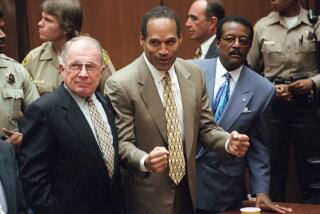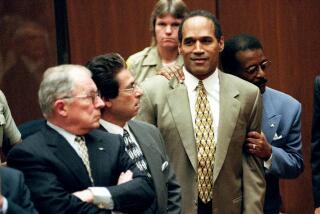Mobilization for Verdict Helped Police Refine Tactics : Law enforcement: Despite some criticism that too many officers were deployed on Saturday, authorities say they were able to improve training, emergency plans and interagency communication.
- Share via
LONG BEACH AREA — Hundreds of tense police officers were all dressed up with nowhere to go.
Having them out in force last weekend--as area residents barbecued chicken and bartered at yard sales--cost taxpayers tens of thousands of dollars. But officials said it was worth it, even if just for the training.
Police officers in Long Beach and Compton, and sheriff’s deputies at the Lakewood station had been preparing for months for the possibility of civil unrest after the federal trial of four Los Angeles police officers involved in the beating of Rodney G. King. Now, officials said, they are better prepared for all crises, including major earthquakes.
“Looting and rioting could occur after any disaster,” said Capt. John Anderson of the Lakewood station. “The Big One is on its way, and now we’re better prepared to deal with that.”
Authorities improved emergency plans, increased training and established better communication between agencies. Law enforcement agencies were as ready as they could be.
In some cases, too ready.
It was such a slow day Saturday that even a couch accidentally set on fire by a transient was enough action to send three Compton patrol cars, carrying six officers, scurrying to the scene.
And in Long Beach that afternoon, eight officers pulled over three cars of teen-agers driving down Santa Fe Avenue, handcuffed two of the youths, sat all of them on a curb and searched their socks and shoes for weapons before releasing them. Police issued one driver a citation for running a red light.
Witnesses complained that the officers were overreacting. But Sgt. John Benedetti downplayed the incident, saying: “We thought they were starting a gang convoy. We just wanted to be safe.”
Keeping the community safe will continue to be the goal as officers apply what they learned over the weekend, officials said.
In Compton, the department plans to have additional officers, if not the entire force, on standby on April 29, the one-year anniversary of last spring’s riots.
“It’s not going to be a routine day. I’m not sure if we’ll have full mobilization or just additional officers as backup, but we’ll have additional people on hand,” said Compton Lt. Joe Flores. “We’ve gone through a dry run now.”
Officials from Long Beach police and the Lakewood sheriff’s station plan to monitor upcoming events, including the anniversary of the 1992 riot and the trial of the men accused of beating truck driver Reginald Denny.
“As we get closer to those events, we’ll take a look at what’s occurring in those cases, pick up intelligence (from the community) and decide what to do,” said Long Beach Police Chief William C. Ellis.
“The lesson we learned a year ago was that we needed to do more training,” Ellis said. “We have a more refined plan now.”
Anderson, of the Lakewood station, said that deputies will be on alert for possible unrest at least through August, when Sgt. Stacey C. Koon and Officer Laurence M. Powell will be sentenced for their roles in the King beating.
Before the verdict Saturday, Long Beach police, like the Compton force and the Sheriff’s Department, had officers on 12-hour shifts.
The total cost of the overtime and additional training has not yet been tallied. The tab in Long Beach for Saturday alone was about $70,000, said department spokeswoman Karen Kerr. In Compton, the department spent about $11,000 a day in overtime since April 13, the first day officers began 12-hour shifts, Flores said.
The law enforcement officials said they plan to continue upgrading training and community policing. Already, planning for possible disturbances following the verdict has helped departments polish their riot-control skills and reach the communities most affected by last year’s unrest.
In Long Beach, for example, nearly 60 officers were dispatched two weeks before the verdict to the commercial corridors that were burned and looted last year, Deputy Chief Tony Van Coutren said.
Part of the officers’ assignment was to gather intelligence on potential post-verdict disturbances and forward the information to a group of detectives assigned to check on rumors, Van Coutren said. The officers also reassured merchants and residents.
*
Merchants along some of the commercial corridors where 159 buildings were either damaged or destroyed last year took no chances last week. A number of businesses along strips such as Anaheim Street, Long Beach Boulevard, Pacific and Atlantic avenues boarded their windows or locked up.
Officer Jay Johnson said he and his co-workers did their best to alleviate any Angst. “We went around to different business owners to calm their anxieties and let them know we’re prepared for anything short of a nuclear war,” he said.
The goal was to be visible even in areas not affected by last year’s riots.
“There were so many fears and rumors everywhere. (And) people living in Cerritos were just as afraid as people living in Long Beach,” Anderson said.
Most neighborhoods in Long Beach and the Southeast, however, saw little activity on the day of the verdict.
Adams Funeral Home in Compton, which features drive-through casket viewing, had a funeral. Across the street, a couple got married at Our Lady of Victory Catholic Church. And nearby in Long Beach, Artemio and Lourdes Marcial spent the day selling oranges out of their aging yellow Chevrolet.
Long Beach and Compton police reported fewer calls for service Saturday, while the Lakewood sheriff’s station reported its numbers were average.
The busiest part of the Southeast area was downtown Long Beach, where more than 73,500 race fans arrived for the 19th annual Grand Prix.
Some spectators said they first waited to listen to the early morning verdict before deciding to join the throngs. “We’re race fans, but our safety is preeminent over our recreation,” said Anaheim Hills resident Kerry Lovdenback, 37.
The Long Beach Police Department, which assigned 50 officers and more than 40 reserve officers to the event, said they were prepared to evacuate the Grand Prix had there been civil unrest. The department’s contingency plan included evacuating the area by leading motorists away from downtown and the Long Beach Freeway (710) to the east side of town, where they could get on another freeway, said Van Coutren of the Police Department.
*
Elsewhere in the city, people seemed to go about their business.
Near Martin Luther King Jr. Park, not far from where Long Beach resident Matthew Haines was killed during the second day of the riots last year, a couple pushed a baby in a stroller past a man washing his car and a little girl jumping rope.
At the Tower of Praise-Revelation Church, members spent the day welcoming neighbors, gang members, the homeless and other celebrants to a giant block party. If tension was in the air, it was drowned out by gospel music blaring from four-foot-high speakers.
And on 7th Street, at the popular Siamese Restaurant, owner Aree Chantravat wasted no time taking down the boards she placed over the large windows Friday night. A few hours after hearing the verdict, she took them down.
“I feel great. I feel great relief,” Chantravat said. “We were stressed and tense. After I heard the verdict, I thought: ‘Everything is going to be OK.’ ”
More to Read
Sign up for Essential California
The most important California stories and recommendations in your inbox every morning.
You may occasionally receive promotional content from the Los Angeles Times.









